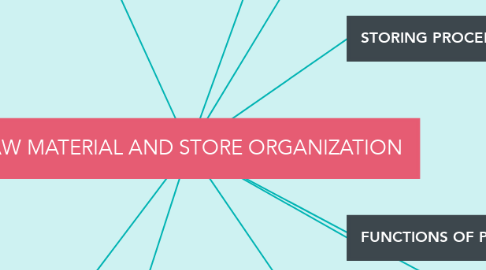
1. * Materials of the desired quality will be availabe when needed for efficient production
2. INTRODUCTION
2.1. One of the essential elements of production
2.2. For example, the flour used to produce cake, brick used to build houses and paper used to produce books
2.3. Objectives
2.3.1. * Material will be purchased only when a need arises and in economic quantities
2.3.2. * The investment in material will be maintained at the lowest level consistent with the operating requirements
2.3.3. * Purchases of material will be made at the most favorable prices under the best possible terms
2.4. Converted by manufacturing processes into finished goods
3. FUNCTIONS OF PURCHASING DEPARTMENT
3.1. To reduce the investment in stock to the lowest level consistent with operating requirements
3.2. To purchase high material at a good price, and ensure the timely delivery of materials
4. PURCHASING PROCEDURES
4.1. Request for material
4.1.1. * Material requisition form
4.1.2. * Purchase requisition note
4.2. Order of material
4.2.1. * Supplier quotation
4.2.2. * Purchase order
4.2.3. * Delivery order
4.2.4. * Supplier invoice
4.3. Inspection and storage of material
4.3.1. * Goods received note
4.3.2. * Inspection note
5. STORING PROCEDURE
6. STORE ORGANIZATION
6.1. Centralized Store
6.1.1. Advantages
6.1.1.1. * A better sote layout where less space is occupied
6.1.1.2. * Placing bulk orders for all departments requirements
6.1.1.3. * It is economical for storing materials
6.1.1.4. * Effective and prompt inventory verification
6.1.1.5. * Wastage of materials can be minimized.
6.1.2. Disadvantages
6.1.2.1. * Delay and inconvenience in sending materials to the department
6.1.2.2. * Increase in material hndling cost
6.1.2.3. * Greater risk of loss by fire
6.1.2.4. * Increase in cost fir movement of stock to the different department
6.2. Decentralized Store
6.2.1. Advantages
6.2.1.1. * Controlling and stoeing function can be accomplished easily
6.2.1.2. * Delay in material handling will be eliminated
6.2.1.3. * Minimizes the chances of loss by the fire
6.2.1.4. * No need for internal transportation costs
6.2.1.5. * Saving in material handling cost
6.2.2. Disadvantages
6.2.2.1. * Higher cost of supervision
6.2.2.2. * More space is required for individual departments
6.2.2.3. * Higher amount of investment is required
6.2.2.4. * More time for stock taking
6.2.2.5. * Higher cost for staff and stationery
7. RAW MATERIAL ISSUING PROCEDURE
7.1. FIRST IN FIRST OUT (FIFO)
7.2. LAST IN FIRST OUT (LIFO)
7.3. WEIGHTED AVERAGE COST (WAC)
8. ECONOMIC ORDER QUANTITY (EOQ)
8.1. EOQ = √2CoD/Cs
8.1.1. Co - Cost per order
8.1.2. D - Total quantity demand
8.1.3. Cs - carrying cost per unit
9. STOCK LEVEL
9.1. Re-order level
9.1.1. Re-order level = Maximum usage X Maximum re-order period
9.1.1.1. Minimum stock level = Re-order level - (Average usage X average re-up order period)
9.2. Maximum stock level
9.2.1. Maximum stock level = re-order level + EOQ - (Minimum usage X Minimum re-order period)
9.3. Minimum stock level
9.4. Average stock level
9.4.1. Average stock level = Maximum stock level + minimum stock level / 2
